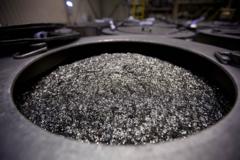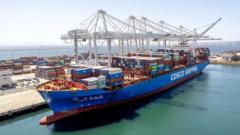China recently imposed restrictions on rare earth mineral exports, revealing America's reliance on these critical materials and impacting U.S. defense and manufacturing sectors.**
China’s Rare Earth Export Restrictions: A Strategic Blow to the U.S. Economy**

China’s Rare Earth Export Restrictions: A Strategic Blow to the U.S. Economy**
As tensions rise in the trade war, China halts exports of crucial rare earth minerals, threatening U.S. industry and defense capabilities.**
In a significant escalation of the ongoing trade war between China and the United States, Beijing has implemented export restrictions on vital rare earth minerals, a move that poses a serious challenge for U.S. industries reliant on these materials. Amidst the mounting tariffs exchanged by both nations, China's decision to limit the availability of these essential resources underscores America's dependency and the strategic implications of such a trade tactic.
Rare earth elements, a collection of 17 chemically similar materials, are integral to the production of numerous high-tech products. Though abundant in nature, these minerals are infrequently found in pure forms and are particularly troubling to extract due to their hazardous nature. Critical applications of rare earths encompass everything from powerful magnets found in electric vehicles and audio systems to essential components in medical technology like MRI machines and defense systems.
China has established dominion over the rare earth market, controlling 61% of production and an astonishing 92% of processing operations globally. This monopoly has evolved over decades, rooted in strategic governmental investments and lower operational costs compared to other nations. The late Chinese leader Deng Xiaoping's assertion that "the Middle East has oil and China has rare earths" aptly summarizes the nation's approach to capitalizing on its mineral resources.
Following recent U.S. tariffs, China has begun restricting the export of several crucial rare earth minerals, particularly heavy rare earths, which play a pivotal role in military applications. These newly enforced regulations require firms to secure export licenses, significantly complicating U.S. access to these materials, especially as processing capabilities remain largely limited outside of China.
Data indicates that from 2020 to 2023, the U.S. imported roughly 70% of all its rare earth minerals from China, highlighting the substantial threat posed by these export controls. Military technologies, including advanced weaponry such as missiles and drones, are heavily dependent on these critical materials. Notably, the rapidly advancing Chinese military capabilities underscore the urgency for U.S. industries to reevaluate their supply chains.
Moreover, to mitigate the fallout from these export restrictions, former President Trump's administration launched initiatives to bolster U.S. production of critical minerals, emphasizing national security and economic resilience. Trump ordered investigations into the risks posed by America's reliance on foreign supplies, aiming to develop domestic capabilities and reduce dependency on China.
Despite intentions to establish alternative sources, the U.S. currently lacks the capacity to independently process heavy rare earth elements and often resorts to sending ores to China for refining. Historically, the U.S. once led the rare earth production sector, but the shift in capabilities began in the 1980s as China's market dominance grew. The exploration of partnerships with other countries, such as Ukraine and Greenland, has recently gained traction as potential means to access rare materials.
Ultimately, this situation poses a dual challenge for the U.S. as it faces increased tension with a critical supplier while alienating potential alternative partners through aggressive trade policies. The long-term impacts of China's export restrictions could profoundly affect U.S. manufacturing, particularly in advanced technology and defense sectors, prompting a strategic reassessment of its resource acquisition strategies in the shifting landscape of global trade.
Rare earth elements, a collection of 17 chemically similar materials, are integral to the production of numerous high-tech products. Though abundant in nature, these minerals are infrequently found in pure forms and are particularly troubling to extract due to their hazardous nature. Critical applications of rare earths encompass everything from powerful magnets found in electric vehicles and audio systems to essential components in medical technology like MRI machines and defense systems.
China has established dominion over the rare earth market, controlling 61% of production and an astonishing 92% of processing operations globally. This monopoly has evolved over decades, rooted in strategic governmental investments and lower operational costs compared to other nations. The late Chinese leader Deng Xiaoping's assertion that "the Middle East has oil and China has rare earths" aptly summarizes the nation's approach to capitalizing on its mineral resources.
Following recent U.S. tariffs, China has begun restricting the export of several crucial rare earth minerals, particularly heavy rare earths, which play a pivotal role in military applications. These newly enforced regulations require firms to secure export licenses, significantly complicating U.S. access to these materials, especially as processing capabilities remain largely limited outside of China.
Data indicates that from 2020 to 2023, the U.S. imported roughly 70% of all its rare earth minerals from China, highlighting the substantial threat posed by these export controls. Military technologies, including advanced weaponry such as missiles and drones, are heavily dependent on these critical materials. Notably, the rapidly advancing Chinese military capabilities underscore the urgency for U.S. industries to reevaluate their supply chains.
Moreover, to mitigate the fallout from these export restrictions, former President Trump's administration launched initiatives to bolster U.S. production of critical minerals, emphasizing national security and economic resilience. Trump ordered investigations into the risks posed by America's reliance on foreign supplies, aiming to develop domestic capabilities and reduce dependency on China.
Despite intentions to establish alternative sources, the U.S. currently lacks the capacity to independently process heavy rare earth elements and often resorts to sending ores to China for refining. Historically, the U.S. once led the rare earth production sector, but the shift in capabilities began in the 1980s as China's market dominance grew. The exploration of partnerships with other countries, such as Ukraine and Greenland, has recently gained traction as potential means to access rare materials.
Ultimately, this situation poses a dual challenge for the U.S. as it faces increased tension with a critical supplier while alienating potential alternative partners through aggressive trade policies. The long-term impacts of China's export restrictions could profoundly affect U.S. manufacturing, particularly in advanced technology and defense sectors, prompting a strategic reassessment of its resource acquisition strategies in the shifting landscape of global trade.





















